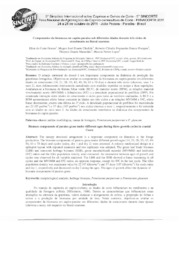Componentes da biomassa em capim-Paraíso sob diferentes idades durante três ciclos de crescimento no litoral cearense.
Componentes da biomassa em capim-Paraíso sob diferentes idades durante três ciclos de crescimento no litoral cearense.
Author(s): GOMES, E. da C.; CÂNDIDO, M. J. D.; POMPEU, R. C. F. F.; MARANHÃO, T. D.; LOPES, M. N.
Summary: Resumo: O arranjo estrutural do dossel é um importante componente na dinâmica de produção das gramíneas forrageiras. Objetivou-se avaliar os componentes da biomassa em capim-paraíso em diferentes idades de crescimento (14; 21; 28; 35; 42; 49; 56; 63 e 70 dias) e durante três ciclos (chuvoso, seco 1 e seco 2), num selineamento inteiramente casualizado com medidas repetidas no tempo e duas repetições. Avaliaram-se a biomassa de lâmina foliar verde (BLV), de material morto (BFM), as relações material vivo/material morto (MV/MM) e folha/colmo (F/C) e a densidade populacional de perfilhos (DPP). Foi constatada interação entre idades de crescimento e ciclos para todas as variáveis analisadas. A BLV e a BFM apresentaram efeito linear crescente às idades nos três ciclos e as relações MV/MM e F/C, efeito linear decrescente, exceto esta última no 3º ciclo. A densidade populacional de perfilhos foi maximizada aos 22 (97 perf?m-2) e 37 dias (107 perf?m-2) nos ciclos chuvoso e seco 1, respectivamente e foi reduzida com as idades no ciclo seco 2. As idades de crescimento interferem na dinâmica dos componentes da biomassa do capim paraíso. [Biomass components of paraiso grass under different ages during three growth cycles in coastal Ceara]. Abstract: The canopy structural arragement is a important component on dinamics to the forage production. The biomass components of paraiso grass under different growth ages (14; 21; 28; 35; 42; 49; 56; 63 e 70 days) and cycles (rainy, dry 1 and dry 2) were assessed. A entirely randomized design in a split-plot layout with repeated measures and two replicates was adopted. The green leaf blade biomass (LBB) and senescent herbage biomass (SHB), green material/death material (MV/MM) and leaf/culm (F/C) ratios and the tiller population density were evaluated. An interaction between ages of growth and cycles was observed for all variable analyzed. The LBB and the SHB showed a linear increasing in all cycles and the MV/MM and F/C ratios, an opposite response, except for F/C in the last cycle. The tiller population density was maximum value by 22 (97 tillers?m-2) and 37 days (107 tillers?m-2) for cycle rainy and dry 1, respectively and decreased on dry 2 along the ages. The ages of growth affect the dynamic of biomass components of paraiso grass.
Publication year: 2011
Types of publication: Paper in annals and proceedings
Unit: Embrapa Goats & Sheep
Observation
Some of Embrapa's publications are published as ePub files. To read them, use or download one of the following free software options to your computer or mobile device. Android: Google Play Books; IOS: iBooks; Windows and Linux: Calibre.
Access other publications
Access the Agricultural Research Database (BDPA) to consult Embrapa's full library collection and records.
Visit Embrapa Bookstore to purchase books and other publications sold by Embrapa.

